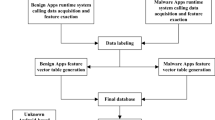Abstract
The existing detection methods of Android mobile malware mainly include signature scanning, heuristic method and behavior monitoring method. These traditional detection methods have a common limitation: they are not adaptive. The detection methods based on artificial immune system, such as dendritic cell algorithm, have some self-adaptability, but they depend too much on artificial experience, and the self-adaptability is obviously insufficient. Therefore, in order to overcome the lack of self-adaptability of existing detection methods, this paper introduces a change perception method based on danger theory to detect malicious software by looking for change in Android mobile phone system, that is, danger signal. When studying the generation of dangerous signal, this paper uses the method of describing the law of function change in mathematics to describe the change in smartphone system with the concept of differential, and then defines and expresses dangerous signal. Considering the discrete type of data in Android mobile phone system, this paper realizes the expression of dangerous signal based on the theory of numerical differentiation, and puts forward the method of calculating dangerous signal in Android system.
This research was financially supported by the Science and Technology Research Program of Hubei Provincial Department of Education (B2017424).
Access this chapter
Tax calculation will be finalised at checkout
Purchases are for personal use only
Similar content being viewed by others
References
Xie, L., Shuang, L.I.: Android malware detection model based on Bagging-SVM. J. Comput. Appl., 3 (2018)
Onwuzurike, L., Almeida, M., Mariconti, E., et al.: A family of droids: analyzing behavioral model based android malware detection via static and dynamic analysis (2018)
Wei, W., Zhao, M., Wang, J.: Effective android malware detection with a hybrid model based on deep autoencoder and convolutional neural network. J. Ambient. Intell. Hum. Comput. 1, 1–9 (2018)
Betarte, G., Campo, J., Gorostiaga, F., et al.: A certified reference validation mechanism for the permission model of android. In: International Symposium on Logic-Based Program Synthesis & Transformation (2017)
Xin, J., Liu, M., Yang, K., et al.: A security sandbox approach of android based on hook mechanism. Secur. Commun. Netw. 2018, 1–8 (2018)
Ping, Y., Zheng, Y.: A survey on dynamic mobile malware detection. Softw. Qual. J., 1–29 (2017)
Liang, X., Li, Y., Huang, X., et al.: Cloud-based malware detection game for mobile devices with offloading. IEEE Trans. Mob. Comput. 16(10), 2742–2750 (2017)
Biedermann, S., Katzenbeisser, S.: Detecting computer worms in the cloud. In: Camenisch, J., Kesdogan, D. (eds.) iNetSec 2011. LNCS, vol. 7039, pp. 43–54. Springer, Heidelberg (2012). https://doi.org/10.1007/978-3-642-27585-2_4
Kim, J.Y., Bu, S.J, Cho, S.B.: Zero-day malware detection using transferred generative adversarial networks based on deep autoencoders. Inf. Sci. (2018). https://www.sciencedirect.com/science/article/pii/S0020025518303475
Ma, Z., Ge, H., Liu, Y., et al.: A combination method for android malware detection based on control flow graphs and machine learning algorithms. IEEE Access PP(99), 1 (2019)
Gao, T., Peng, W., Sisodia, D., et al.: Android malware detection via Graphlet sampling. IEEE Trans. Mob. Comput. PP(99), 1 (2018)
Narayanan, A., Chandramohan, M., Chen, L., et al.: A multi-view context-aware approach to Android malware detection and malicious code localization. Empir. Softw. Eng. 6, 1–53 (2017)
King, R.L., Lambert, A.B., Russ, S.H., Reese, D.S.: The biological basis of the immune system as a model for intelligent agents. In: Rolim, J., et al. (eds.) IPPS 1999. LNCS, vol. 1586, pp. 156–164. Springer, Heidelberg (1999). https://doi.org/10.1007/BFb0097896
Banirostam, T., Fesharaki, M.N.: Immune system simulation with biological agent based on capra cognitive framework. In: UKSIM International Conference on Computer Modelling & Simulation (2011)
Sulaiman, N.F., Jali, M.Z., Abdullah, Z.H., et al.: A study on the performances of danger theory and negative selection algorithms for mobile spam detection. Adv. Sci. Lett. 23(5), 4586–4590 (2017)
Zhang, Z., Lun, L., Zhang, R.: Danger theory based micro immune optimization algorithm solving probabilistic constrained optimization. In: IEEE International Conference on Computational Intelligence & Applications (2017)
Secker, A., Freitas, A.A., Timmis, J.: A danger theory inspired approach to web mining. In: Timmis, J., Bentley, Peter J., Hart, E. (eds.) ICARIS 2003. LNCS, vol. 2787, pp. 156–167. Springer, Heidelberg (2003). https://doi.org/10.1007/978-3-540-45192-1_16
Hashim, F., Munasinghe, K.S., Jamalipour, A.: A danger theory inspired survivability framework for the next generation mobile network. IEEE Lat. Am. Trans. 8(4), 358–369 (2010)
Weigold, T., Kramp, T., Hermann, R., et al.: The Zurich trusted information channel—an efficient defence against man-in-the-middle and malicious software attacks. In: International Conference on Trusted Computing & Trust in Information Technologies: Trusted Computing-challenges & Applications (2008)
Park, C.S., Lee, J.H., Seo, S.C., et al.: Assuring software security against buffer overflow attacks in embedded software development life cycle. In: International Conference on Advanced Communication Technology (2010)
Lin, X., Yuan, Y., Wang, W., et al.: Stabbing the sky: efficient skyline computation over sliding windows. In: International Conference on Data Engineering (2005)
Author information
Authors and Affiliations
Corresponding author
Editor information
Editors and Affiliations
Rights and permissions
Copyright information
© 2019 Springer Nature Switzerland AG
About this paper
Cite this paper
Zhang, Hl., Yang, Hy., Yang, F., Jiang, W. (2019). Malware Detection in Android System Based on Change Perception. In: Huang, DS., Bevilacqua, V., Premaratne, P. (eds) Intelligent Computing Theories and Application. ICIC 2019. Lecture Notes in Computer Science(), vol 11643. Springer, Cham. https://doi.org/10.1007/978-3-030-26763-6_35
Download citation
DOI: https://doi.org/10.1007/978-3-030-26763-6_35
Published:
Publisher Name: Springer, Cham
Print ISBN: 978-3-030-26762-9
Online ISBN: 978-3-030-26763-6
eBook Packages: Computer ScienceComputer Science (R0)




